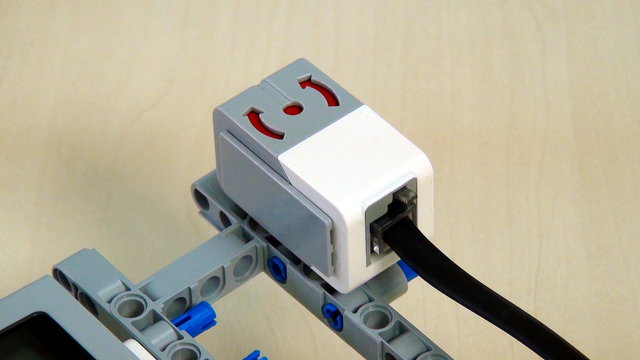

Teacher's Notes: Naming the parts and vocabulary of the students
Do your best as a teacher to make sure students are expanding their vocabulary on every occasion.
- #346
- 26 Jan 2017


Do your best as a teacher to make sure students are expanding their vocabulary on every occasion.


We will cover the names and the basic usage of the parts in our typical robot.


There are some things to be careful about when your students work with the brick.


Let's review the LEGO Mindstorms EV3 Intelligent Brick
The EV3 brick is the main computer of your LEGO robot and it has a display, a few buttons and various ports.

Overview of what is going to happen in module 3


What a teacher must look out for, while students are building a robot from instructions.


There are a few things that you should be careful about when building from instructions .


We will build the EasyBot quick robot and will explain how to follow building instructions.


When organizing this course, the behavior expectations should be set at the very beginning of the course.


We have the following behavior expectations from you during this course:
You ask the question.
You will probably err before you succeed.
You should work as a team. Share solutions with others, help them and allow them to help you.
When the teacher speaks, this is important to everyone.
You should read your lesson before you come to class.


There are some fundamental rules that we advise you to follow while organizing this course with students. Let's look at them.

In this course, you will work with other students in the group. These might be your classmates, teammates, or students you know from other activities. It is important to know your group so that you can work together with them in the best possible way.


Tasks for the Gyro sensor that you can use in STEM classes, while preparing for a competition or just to explore how the sensor works.


The Gyro sensor can be positioned horizontally, vertically or at a random angle. Have you ever wonder what does the gyro detect when it is positioned vertically. This is the subject of this video tutorial for the LEGO Mindstorms EV3 Gyro Sensor.


Let's explain the problem of just waiting for the Gyro sensor to detect an angle and think of why the robotics systems work like that.

Turning with the Gyro Sensor on a specified angle and stopping there have never been easy. It is not going to get any better. However, this is not a problem of the Gyro sensor. The problem is in the way we develop our programs.

The Gyro sensor in LEGO Mindstorms EV3 sets is new for the sets and we answer basic questions about its usage. The sensor detect when the whole constructions turns at a particular angle, but there are a number of gotchas in using it.

The EV3 Gyro sensor is quite powerful, but there are some little tricks when using it. In the previous episode we showed a hardware solution to the problem and now we are exploring how could the sensor be calibrated from the EV3-G software. Thanks to Sharon and Faye (full names omitted) for the request for this video.


Many teams are having troubles with the EV3 Gyro Sensor and its drift. In this video we are showing one way to fix this behaviour and get an accurate measurement from the sensor.

The robot uses one middle motor. This middle motor with the use of a few gear systems controls for different axsels. We have attached wheels on this axles so it is very easy to extend the robot construction for additional LEGO Mindstorms active attachments


This robot has a color sensor and this sensor is used for following lines. Additional Mindstorms EV3 sensors could be place on the robot, like a Gyro sensor or a second Color sensor.


One of the very good things about box robots is that you could easily align with them both to the front, to the back or to the rear sides. This aligning is helpful for FIRST LEGO League, World Robotics Olympiad or other robotics competitions with LEGO Mindstorms EV3/NXT robots.


With the EV3 Mindstorms set you receive three motors. Two are large and one is medium. These three motors could be used in different configurations and in this video we show how to use the motors on the second box robot for competitions that we build.


Cable management is very important on each competition. Cables could get in the way of attachments, levers, different wheels and so on. Brick accessibility is also very important. Do not forget that the brick should be charged from time to time and that you should also be able to access the buttons.


This robot could quite possibly be build from a single EV3 core and EV3 resource sets. It uses fewer parts and only three motors. There are additional parts that could be skipped when building the robot and we have added these parts only as to make the construction more complete.

Here we start with a second box robot that we would like to build. It is in a way improvement to the first robot and we would take a look at its features.


One more example for an active attachment with a system of gear wheels. This time the system is constructed so that the attachment could lift heavy objects.